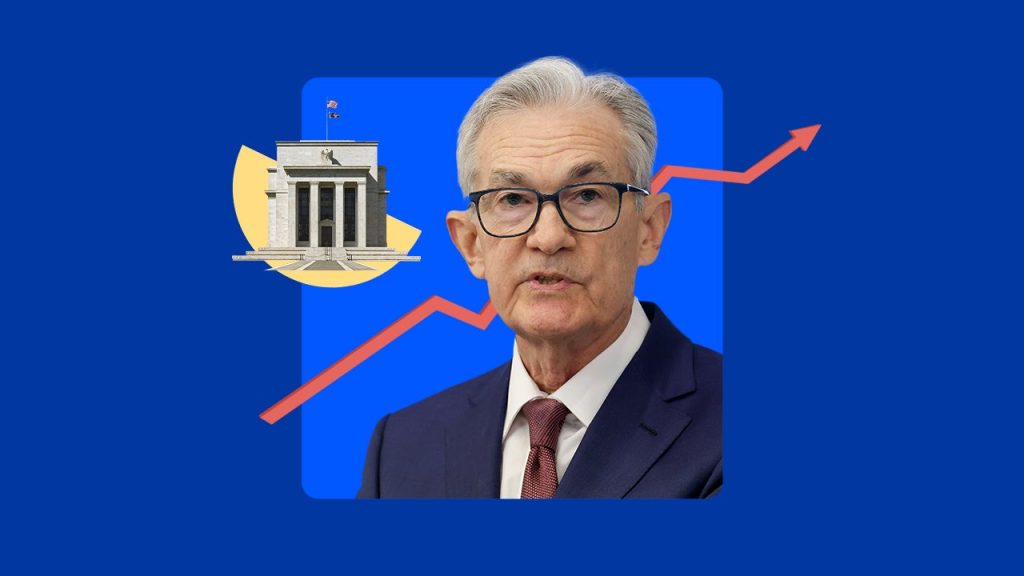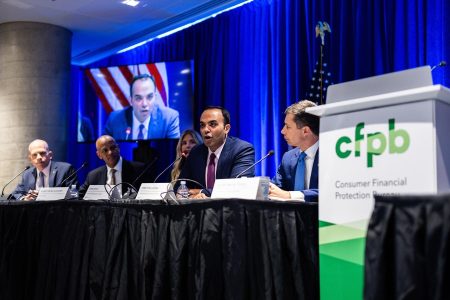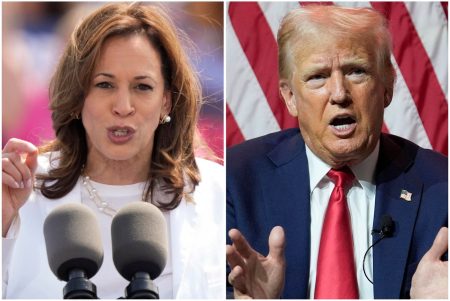Key takeaways
- Federal Reserve officials may be starting to rethink just how much they’ll be able to cut interest rates in 2024, as inflation stays stubbornly above their 2 percent goalpost.
- Even with inflation more stubborn, officials might not yet think it’s necessary to raise interest rates, now that they’re judging that the risks of doing too much match the consequences of doing too little.
- The Fed is expected to soon announce that it’ll start slowing how much it’s been shrinking its balance sheet.
At the start of the year, the nation’s top economists thought the Federal Reserve would be using its May rate announcement to tee up the first cut of its fiercest inflation-fighting regime in 40 years.
Now, as inflation stays more stubborn than expected, they’re wondering whether those cuts are delayed — or completely canceled.
It’s been a tough three months for the inflation-focused Federal Open Market Committee (FOMC). At the end of 2023, a rare combination of slowing inflation and resilient hiring made the illusive “soft landing” of the U.S. economy appear in reach. The latest data, however, shows that consumer prices have been topping expectations again, even as growth in the first three months of 2024 slows more than expected.
Inflation is on pace to hit 4.5 percent by March 2025 if the trends of the past three months continue for a full year, thanks to a pop in energy prices as well as elevated shelter, medical care and insurance costs, Bureau of Labor Statistics data shows. That’s more than double the Fed’s official 2 percent target and up from a 1.9 percent three-month annualized pace just four months ago.
Those reports foreshadowed similar setbacks in the Fed’s preferred inflation gauge from the Department of Commerce. Excluding food and energy, those prices topped a 3.7 percent annualized rate in the first quarter of 2024, after two straight quarters of it matching the Fed’s 2 percent target.
Policymakers currently have no reason to move rates in either direction, as employers’ historic hiring spree keeps unemployment below 4 percent for the longest stretch of time since the 1960s. But for consumers, the message remains clear: Financing rates on loans from mortgages to credit cards are likely to stay high — a price U.S. central bankers consider worth paying to defeat inflation.
To be in a situation where the economy has remained resilient enough that the Fed has to keep rates at their current levels in order to get inflation down, that’s a much more positive outcome than had been expected this time last year.
— Greg McBride, Bankrate Chief Financial Analyst
1. Economists say the bar for a rate cut is still higher than a rate hike
With nothing but bad news on the inflation front lately, both economists and investors have started to doubt whether the Fed will be able to justify the three rate cuts that officials were projecting as recently as March. Whispers of the Fed debating whether to raise interest rates again have even started growing.
“It may not be able to cut at all in 2024,” wrote Diane Swonk, chief economist at KPMG, in a note after a Commerce Department report that showed growth slowing and inflation jumping more than expected. “Some participants at the May Fed meeting are likely to raise discussion about the possibility of rate hikes.”
No matter what, officials will let the data do the talking, and the U.S. economy could evolve differently by the Fed’s September meeting, the soonest Fed officials might now cut rates, according to most of the economists who are still projecting them.
But the Fed’s next move aside, a regime shift at the U.S. central bank may already be underway — influencing how they may respond to these recent hiccups.
When the Fed first began raising interest rates, Chair Jerome Powell acknowledged that a period of “below-trend” growth may be required to get inflation down to target. He indicated a willingness at the U.S. central bank to keep rates high, even if it meant a recession or higher unemployment.
“These are the unfortunate costs of reducing inflation,” Powell said in August 2022 during a keynote at the Fed’s annual monetary policy symposium in Jackson Hole. The tough-talking chief central banker’s speech sparked a rout in stocks and a surge in bond yields that would last until the fall. “But a failure to restore price stability would mean far greater pain.”
That compares with Powell’s latest post-meeting press conference in March 2024, during which he admitted that the Fed could begin cutting rates if there was a “significant weakening” in the labor market.
“One of the underappreciated things the Fed has done since January is to very explicitly say that both sides of the mandate get equal play from here,” says Luke Tilley, chief economist at Wilmington Trust. “For a couple years there, the focus was on inflation because it was so high.”
The inflation-first mindset likely started to change as officials watched inflation dip from a staggering 40-year high of 9.1 percent in June 2022 to 3 percent by June 2023, all while unemployment held relatively stable. Officials learned that low unemployment didn’t always have to be inflationary. Meanwhile, the gap between the national inflation and unemployment rates started closing.
The day the Bureau of Labor Statistics’ consumer price index (CPI) showed that prices topped expectations for a third straight month in March, records from the Fed’s March rate-setting meeting indicated that participants saw their two goals of stabilizing inflation but also retaining maximum employment as “moving into better balance.”
“They remarked that it was important to weigh the risks of maintaining a restrictive stance for too long, which could unduly weaken economic activity and employment, against the risks of easing policy too quickly,” the minutes said.
Meanwhile, Powell added in remarks on April 16 that he thinks it’ll likely still be appropriate to cut rates this year, even though officials might wait longer than they initially thought to kickstart the process.
Another important factor to consider is the “real” level of interest. When asked about whether the Fed should raise interest rates more from here, voting Chicago Fed President Austan Goolsbee said in his last remarks before the Fed’s upcoming meeting that policy will keep tightening as inflation slows, even if interest rates stay the same.
Those reasons might be why officials aren’t seriously beginning to debate whether the pick up in inflation warrants more rate hikes — at least yet.
“The bar is noticeably higher for a rate hike,” says Ryan Sweet, chief economist at Oxford Economics. Sweet moved down his projection for the Fed’s first rate cut from June to September and now expects just two cuts this year. “For the Fed to cut interest rates, they need to see a few more months of better inflation data. It doesn’t have to be a marked deceleration; it just has to not get any worse.”
2. Is inflation reaccelerating or just taking longer to slow? Only time will tell
For now, the hope is that inflation is just taking a bit longer to retreat to 2 percent — rather than reaccelerating altogether.
Economists say a number of factors could be to blame for price pressures getting stuck in their current 3 percent purgatory. For starters, supply tensions and conflict in the Middle East may be behind the recent pop in energy prices, which accounted for one-fifth of the increase in prices between February and March, CPI data shows.
To get a look at underlying inflation, economists prefer to track a gauge that excludes those volatile prices. So-called core prices fell from 5.6 percent in January 2023 to 3.8 percent in March, where it’s been in a holding pattern since February.
Meanwhile, some of the current drivers of inflation — shelter and car insurance — could be lagging everything else. A sign of a housing cooldown to come, rents rose by the slowest pace since 2010 in a new “experimental” rent index from BLS intended to track housing costs in real time. Meanwhile, car insurance companies have been hiking premiums to catch up with the massive jump in medical care and repair costs from the past two years.
Economists in Bankrate’s Q1 Economic Indicator poll acknowledged that there’s a risk inflation won’t reach 2 percent until the end of 2025 or 2026. Waiting to cut interest rates gives Fed officials the time they need to reassess whether inflation is just in a holding pattern or climbing in altitude.
“I’m not too concerned that recent data on inflation is signaling that inflation is moving in the wrong direction,” Sweet says. “It’s just we’ve hit a little bit of a speed bump.”
Risks, however, remain. While the Fed can’t influence the supply side of the economy, higher gasoline and fuel prices could find their way to the consumer if companies have to pass along higher transportation costs by raising prices.
“The last several months where we did see material progress on inflation, we had the tailwind of falling gasoline and oil prices,” McBride says. “We don’t have that now, and lo and behold, the trend on inflation is different.”
What voting Fed officials are saying about rate cuts
The recent data have clearly not given us greater confidence and instead indicate that it is likely to take longer than expected to achieve that confidence.
— Jerome Powell, Federal Reserve Chairman
If it seems that the level of restrictiveness that we’re at today is not enough to do the job or get the job done, I’d have to be open to increasing rates.
— Raphael Bostic, Atlanta Fed President
After three months of this, it can’t be dismissed. Right now, it makes sense to wait and get more clarity before moving.
— Austan Goolsbee, Chicago Fed President
My expectation right now is that interest rates are in a good place and, eventually, at some point, we would want to lower interest rates as the economy really gets to the 2 percent inflation that we’re headed towards.
— John Williams, New York Fed President
3. Fed officials may tweak their balance sheet policy, a lesser-known tool that still finds its way to consumers’ wallets
Separate from the Fed’s interest rate policy is an expected upcoming announcement on how the U.S. central bank plans to continue adjusting the amount of cash circulating in the banking system. It’s a confusing, yet consequential, decision for consumers because it could ultimately be another lever that impacts the borrowing costs they pay — especially if something goes wrong.
Since September 2022, the Fed has been letting up to $60 billion in Treasury securities and $35 billion in mortgage-backed securities roll off its balance sheet at maturity. The Fed purchased those assets in the wake of the coronavirus pandemic, a form of “unconventional” monetary policy that effectively increased the money supply.
The Fed grows its balance sheet to stimulate demand and weigh on longer-term interest rates, such as the 30-year fixed-rate mortgage. But the same is true vice-versa. By letting assets roll off, Fed officials are effectively weighing on the availability of credit in the economy.
What is the Fed’s balance sheet?
Find out more about this behind-the-scenes Fed policy move that has major implications for your wallet.
Read more
Fed officials, however, don’t want to take the process too far. While normalizing their balance sheet after the financial crisis, officials back in 2019 lost control of a key interest rate that’s supposed to stay within the Fed’s desired target range for the federal funds rate. Known as the repurchase, or “repo,” rate, it surged as high as 9 percent during one trading day, despite the federal funds rate at the time holding in a target range of 2-2.25 percent, an analysis from the Richmond Fed found.
The repo market is often seen as the “beating heart” of financial markets. Trouble in that corner of the financial system can reverberate across the entire U.S. economy, making it harder — and temporarily more expensive — to access credit.
Today, officials acknowledge that shrinking their balance sheet too much likely contributed to the dysfunction. Back then, officials had taken roughly $700 billion out of the system. Today, however, they’ve vacuumed up even more — almost $1.6 trillion.
“There can be times when, in the aggregate, reserves are ample or even abundant, but not in every part. And those parts where they’re not ample, there can be stress,” Powell said at the Fed’s March post-meeting press conference, alluding to that turmoil five years ago. “That can cause you to prematurely stop the process to avoid the stress. And then it would be very hard to restart.”
Powell revealed at the Fed’s March meeting that it’ll soon be time for officials to discuss the next phase for their balance sheet policy. On deck is an announcement about when “tapering” could start and by how much.
What the Fed’s next announcement means for you
The Fed’s plans to keep interest rates higher for longer means it’s an important time for consumers to prioritize devising a plan for paying off any high-interest debt and building up an emergency fund so they’re well-prepared for any unexpected expense.
- A significant accelerator for your debt repayment plan are balance-transfer cards, which currently offer up to a 0 percent introductory annual percentage rate (APR) for around 21 months, according to Bankrate’s latest findings.
- Higher for longer interest rates mean banks are still offering the best returns on consumers’ deposits in over a decade. The top-yielding online bank is currently offering a 5.35 percent annual percentage yield (APY), Bankrate’s latest rankings show. An added bonus of a high yield is that it can help you grow the funds you use for unexpected expenses or longer-team goals even quicker. At these current levels, a 5.35 percent APY could generate $535 in interest in one year on a $10,000 deposit.
- Customers still have the opportunity to lock in those higher yields for the long term through a certificate of deposit (CD). Yields on 5- and 1-year CDs were falling fast as it looked like the Fed was about to cut interest rates. They’ve now since stabilized, and most important for consumers, are continuing to top inflation. The best 1-year CD can lock in a 5.36 percent APY, while 5-year CDs are currently paying a top yield of 4.55 percent. If you’re fine with locking away the funds, those yields could help make sure you’re still earning a decade-smashing yield, even if rates do eventually begin to drift lower.
“Paying down debt is going to be the quickest way to give yourself relief from the cost of interest,” McBride says. “From the savings side, let the good times roll.”
Read the full article here












